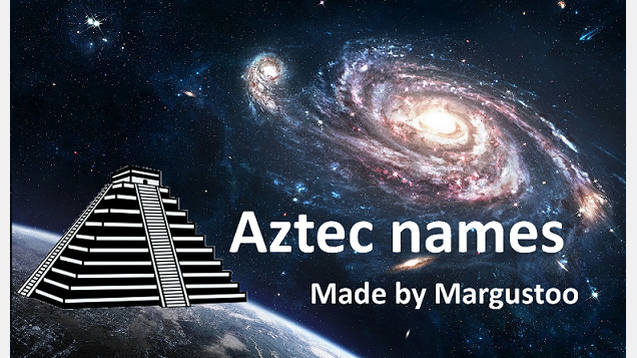


Tlamanih – These Aztec warriors were tasked to find captures for the gods.Xochipilli – Xochipilli was the Aztec god of music and loe.Zolin – This sweet Aztec name refers to the quail, a tiny yet beloved bird that dwells in Mexico.Quetzalcoatl – The feathered serpent is one of the most respected gods in the Aztec pantheon.This one means “precious twin” in Nahuatl.

The Cipactli is said to be part crocodile, part fish, and part frog. Cipactli – This is the name of a sea monster from Aztec mythology.Necuametl – This grand Aztec moniker means “king.”.Mictlantecuhtli – Once a common Aztec boy’s name, Mictlantecuhtli was also the god of the Aztec underworld.Tezcatlipoca – This intense mythological Aztec name refers to the god of the night sky and war.Cuauhtémoc – This name means “descending eagle.” It belonged to the last Aztec emperor.Ehécatl – As the god of the wind, Ehécatl is often represented with an odd blowing contraption on his head.Acamapichtli – Acamapichtli is an Aztec name that means “handful of reeds.” It is also the name of the first Aztec emperor.Itzcoatl – This Aztex emperor helped strengthen the ancient civilization.Ohtli – This two -syllable Aztec name means “champion.”.Ahuitzotl – Ahuitzotl was a brave Aztec warrior who was well -known for his conquests throughout present -day Guatemala and the Gulf of Mexico.His turbulent relations with Spanish conquistador Cortés are very well documented. Moctezuma – Moctexuma, or Montezuma, was the ninth emperor of the Aztec empire.These texts contain text and images that documented daily life before the Spanish Conquest. Amoxtli – The Mēxihcatl āmoxtli are Aztec codices.Less often seen were Nahuatl names honoring past Aztec emperors, as these were considered great honorifics within the empire and were reserved for royalty within the Aztec system of nobility. The Nahuatl language is still spoken by nearly 1.5 million people today, the majority of whom reside in El Salvador and Central and Coastal Mexico. The people of the Aztec empire spoke a language called Nahuatl, and as such, Aztec names may also be referred to as Nahuatl names. Naming children after deities became a very common practice, as did drawing names from flowers, trees, animals, and other aspects of the natural world. Within the Aztec culture, both religion and nature were viewed as paramount. Today, their history remains foundational in the establishment of Mexico’s national identity, and names which were popular during the rise and fall of the Aztec Empire remain in fairly common use. The Mesoamerican Aztec peoples, who lived in central Mexico between the 1300s and 1500s, were known for choosing names reflective of their devotion to both nature and their polytheistic worship.


 0 kommentar(er)
0 kommentar(er)
